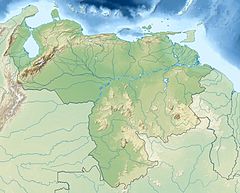Caura National Park
Caura National Park (Parque nacional Caura) is a protected national park in Venezuela.[1] It is 7,534,000 ha. (75,340 km2) in size. It is the largest park in Venezuela. It is also the newest. It was made a park in 2017.[2]
| Caura National Park Parque nacional Caura | |
|---|---|
IUCN category II (national park) | |
 | |
| Location | |
| Coordinates | 7°38′08″N 64°52′59″W / 7.63556°N 64.88306°W |
| Area | 75,340 km2 (29,090 sq mi) |
| Established | 2017 |
The Caura River is part of the of the Orinoco River. It drains an area of the Guianan Highlands moist forests.
History
changeIn 1968, the government of Raúl Leoni decided to make places into parks. In 2008 the government of Hugo Chávez made the Caura Plan to protect the resources of this river basin.
In March 2017[3] the government led by Nicolás Maduro made the Caura National Park between the states of Bolívar and Amazonas.[4] Its first management plan was in March 2018.
Living things
changePlants
changeThis park has tropical rainforest in it. The most important plant species are cabimo oil, carob tree, araguaney, mahogany and carapa. The place has a surface of 7.534.000 Ha. (75.340 km2), average annual temperature of 32 °C (90 °F) and average annual rainfall of 2,271 mm (89.4 in).
Animals
changeThe animals in Caura National Park include tapirs (Tapirus terrestris), white-cheeked peccary (Tayassu pecari), white-tailed turkeys (Crax alector) and red-tailed turkeys (Mitu tomentosum), the anteater (Myrmecophaga tridactyla), the limpet (Cuniculus paca), the beak (Myoprocta pratti), the collared peccary (Pecari tajacu), the yellow-bellied spider monkey (Ateles belzebuth), rabipelados (Didelphis marsupialis), cachicamos (Dasipus spp), and deer and cranes. It also has large meat-eating animals, for example the jaguar (Panthera onca), puma (Puma concolor) and tayra (Eira barbara). Many of these animals are affected by hunting pressure due to population growth, according to research by the University of Washington and the Wildlife Conservation Society published in 2016.
See also
changeReferences
change- ↑ "El Parque Nacional Caura y sus contradicciones". El Nacional (in Spanish). 2017-04-20. Retrieved 18 December 2021.
- ↑ "Venezuela: científicos y pueblos indígenas critican la creación del Parque Nacional Caura". Noticias ambientales (in Spanish). 2017-06-21. Retrieved 2019-11-29.
- ↑ Grupo de Trabajo sobre Asuntos Indígenas (GTAI) (2017-04-05). "Sobre el Decreto del Parque Nacional Caura". Revista SIC - Centro Gumilla (in Spanish). Archived from the original on 2020-10-29. Retrieved 2019-11-29.
- ↑ Azuaje, Atilano (5 April 2017). "Sobre el Decreto del Parque Nacional Caura". Revista SIC - Centro Gumilla (in Spanish). Archived from the original on 29 October 2020. Retrieved 24 October 2019.
